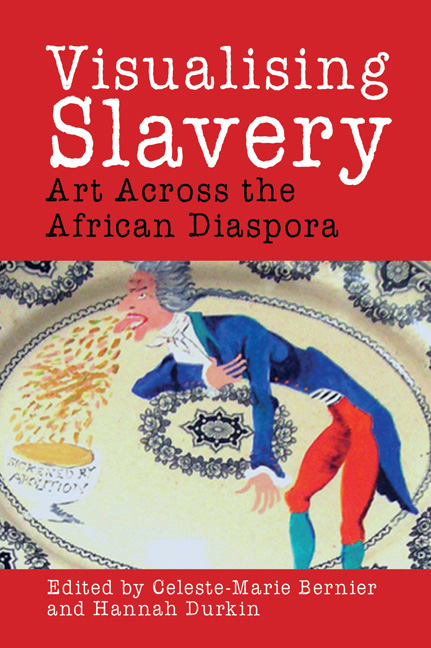Book contents
- Frontmatter
- Dedication
- Contents
- List of Illustrations
- Acknowledgements
- Introduction: ‘Inside the Invisible’: African Diasporic Artists Visualise Transatlantic Slavery
- Part I Slavery and Memory in Contemporary African Diasporic Art
- Part II Historical Iconography and Visualising Transatlantic Slavery
- Part III African Diasporic Monuments and Memorialisation
- Part IV Contemporary Legacies in African Diasporic Art
- Chapter 13 We Might Not Be Surprised: Visualising Slavery and the Slave Ship in the Works of Charles Campbell and Mary Evans
- Chapter 14 ‘X is for X Ray, X Slave, X Colony’: A ‘Lexicon of Liberation’ versus ‘My Slave History’ in the Paintings, Installations and Sketchbooks of Donald Rodney
- Chapter 15 Reconfiguring African Trade Beads: The Most Beautiful, Bountiful and Marginalised Sculptural Legacy to Have Survived the Middle Passage
- Afterword: Against the Grain: Contingency and Found Objects
- Notes on Contributors
- Index
- Platesection
Chapter 13 - We Might Not Be Surprised: Visualising Slavery and the Slave Ship in the Works of Charles Campbell and Mary Evans
from Part IV - Contemporary Legacies in African Diasporic Art
- Frontmatter
- Dedication
- Contents
- List of Illustrations
- Acknowledgements
- Introduction: ‘Inside the Invisible’: African Diasporic Artists Visualise Transatlantic Slavery
- Part I Slavery and Memory in Contemporary African Diasporic Art
- Part II Historical Iconography and Visualising Transatlantic Slavery
- Part III African Diasporic Monuments and Memorialisation
- Part IV Contemporary Legacies in African Diasporic Art
- Chapter 13 We Might Not Be Surprised: Visualising Slavery and the Slave Ship in the Works of Charles Campbell and Mary Evans
- Chapter 14 ‘X is for X Ray, X Slave, X Colony’: A ‘Lexicon of Liberation’ versus ‘My Slave History’ in the Paintings, Installations and Sketchbooks of Donald Rodney
- Chapter 15 Reconfiguring African Trade Beads: The Most Beautiful, Bountiful and Marginalised Sculptural Legacy to Have Survived the Middle Passage
- Afterword: Against the Grain: Contingency and Found Objects
- Notes on Contributors
- Index
- Platesection
Summary
One of the most fascinating aspects of contemporary artists’ attempts to visualise slavery is the extent to which such images relate as much to the present day as they might to the historical traumas and experiences they seek to reference. Though contemporary artists may lay claim to, or may utilise, eighteenth- or nineteenth-century imagery in their work, the resulting pieces often speak as much, if not more, to late twentieth-or early twenty-first-century narratives of history and identity as to the historical subject matter the original images depict. There is perhaps a certain inevitability to this, which is substantially reflected in television or cinematic interventions into narratives of slavery and the slave trade. The television production of Alex Haley's Roots (1977) probably told us as much, or more, about race in the mid-1970s United States as it did about the particular saga of Haley's family tree. More recently, films such as the biopic Amazing Grace (2006) (directed by Michael Apted and based loosely on the life of anti-slavery MP William Wilberforce) probably told us as much or more about the climate of benevolent liberalism and partiality that by and large characterises the British people's attitudes to matters of slavery and abolition today as about the historical slave trade itself. The fascinating set of postage stamps issued by the Royal Mail in 2007 probably told us as much as or more about the Blair government's questionable Abolition 200 project as the stamps themselves did about the historical figures they sought to memorialise. More recently, Steve McQueen's biopic 12 Years a Slave (2013) (based loosely on the vivid recollections of Solomon Northup, a free Black man kidnapped into slavery, concerning his subsequent nightmarish existence) probably told us more, or as much, about the United States in the era of Obama than it did about slavery in the nineteenth-century US. Time and time again, we see the ways in which images of slavery and the slave trade have this fascinating ability to shuttle between considerations of the past and the present.
When it comes to the work of present-day practitioners, we might not be surprised at this intriguing characteristic. After all, Black British artists, and Black artists from elsewhere in the African diaspora, have frequently come to use images of slavery as a means of understanding, coming to terms with or making sense of present-day circumstances.
- Type
- Chapter
- Information
- Visualising SlaveryArt Across the African Diaspora, pp. 203 - 217Publisher: Liverpool University PressPrint publication year: 2016

